When we think of self-care, many of us imagine bubble baths, meditation, or perhaps a quiet walk in nature. But what about fashion? A therapeutic wardrobe? The way we dress has a powerful impact on how we feel. Our clothes can uplift us, offer comfort, and even empower us to face the world with more confidence. Fashion, when approached thoughtfully, can become a form of self-care-a way to nourish both body and mind.
So, how do you build a wardrobe that's not only stylish but also emotionally supportive? Let's explore the concept of a therapeutic wardrobe and how to curate clothing that makes you feel good inside and out.
1. Start with Comfort: Prioritise How Clothes Feel, Not Just How They Look
One of the simplest yet most transformative elements of a therapeutic wardrobe is comfort. Comfort doesn't mean sacrificing style-in fact, the most stylish outfits are often the ones we feel great wearing. Whether it's a cosy knit jumper, a soft cotton t-shirt, or a perfectly tailored pair of trousers, the key is to choose pieces that make you feel comfortable physically, mentally and emotionally,
Fabrics play a huge role in comfort. Natural fibres like cotton, silk, and cashmere feel luxurious on the skin and allow your body to breathe, while materials like jersey and knitwear offer softness and flexibility. When you wear something that feels good against your skin, it can instantly change your mood. A snug, well-fitted jumper on a chilly day feels like a warm hug, while a flowy silk dress can lift your spirits with its lightness and movement.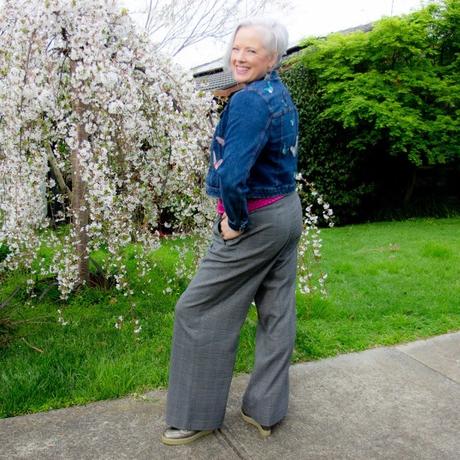
I love denim jackets that have elastane in them so they stretch and move with my body, like the one above. Plus these pants are roomy and super comfy yet more dressy than a pair of jeans.
Style Tip: Build a foundation of comfortable, high-quality basics in your wardrobe. Think well-fitting jeans, soft tees, and cosy sweaters that you'll reach for time and time again. These pieces act as the foundation for a therapeutic wardrobe that makes you feel at ease.
2. Dress to Empower: Clothing as a Confidence Booster
Self-care isn't just about feeling cosy; it's also about feeling empowered. Sometimes the simple act of putting on a well-structured blazer or a favourite bold accessory can give you that extra boost of confidence you need to tackle the day. When you dress in a way that aligns with how you want to feel-powerful, calm, creative, or confident-you send a message to yourself and the world about who you are.
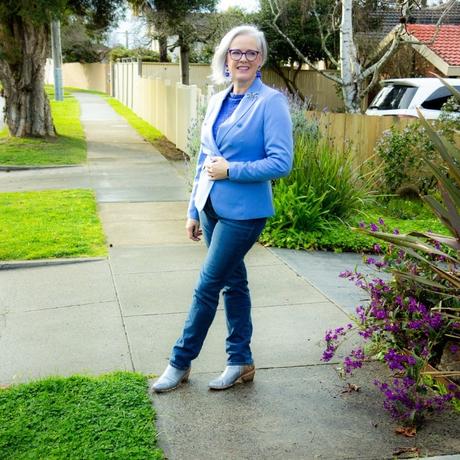
A blazer can cover a multitude of sins in a signature colour gives me confidence.
Colour plays a significant role in this. Colours can affect your mood and energy levels, so it's important to choose shades that resonate with how you want to feel. Bold reds and vibrant yellows can energise and inspire confidence, while soft pastels or deep blues can bring a sense of calm and serenity.
In my 7 Steps to Style program, I work with women to discover their unique colour palettes and signature colours based on their natural colouring and personal preferences. Knowing what colours make you look and feel your best is an empowering step in building a therapeutic wardrobe.
Style Tip: Try adding one or two pieces in a colour that makes you feel confident. Whether it's a bright red dress for an important meeting or a soft blue blouse for a day when you need a little extra calm, dressing with intention can have a huge emotional impact.
3. Curate a Capsule of Feel-Good Fabrics
Certain fabrics have a way of making us feel supported and nurtured, both physically and emotionally. A therapeutic wardrobe often includes a mix of textures that bring comfort and joy. For example, a soft wool cardigan can be a comforting layer on cold days, while a smooth silk blouse can make you feel elegant and grounded.
It's also worth considering the emotional associations that different fabrics evoke. Linen, for example, is often associated with relaxation and summer holidays, while velvet might bring a sense of luxury and indulgence. As you curate your therapeutic wardrobe, think about the fabrics that comfort and empower you. Does it calm you? Energise you? Bring back happy memories? Incorporating these sensory details into your wardrobe can enhance the therapeutic quality of your clothing.
Style Tip: Try layering different fabrics for both comfort and visual interest. Mixing textures like soft knits, sleek silks, and structured denim can create a balanced, tactile experience that feels good throughout the day.
4. Clothing Rituals: Mindful Dressing for Emotional Support
Building a therapeutic wardrobe also involves creating daily rituals around how you dress. The process of selecting and putting on clothes can become a moment of mindfulness-an opportunity to slow down and connect with yourself. Rather than rushing through the morning routine, try taking a few moments to think about how you want to feel that day and choose an outfit that reflects that intention.
Maybe on a stressful day, you reach for a soft, oversized jumper that helps you feel cocooned and protected. On days when you need to feel more focused and energised, a structured, tailored jacket might give you the confidence to tackle your tasks. By being intentional with your clothing choices, you can create a wardrobe that supports your emotional needs throughout the day.
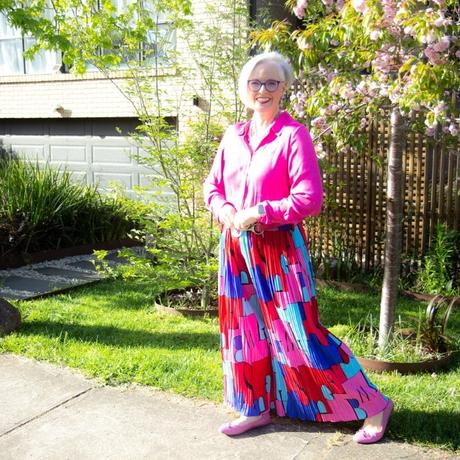
When I feel like I need a boost, I reach for an outfit that may be a bold colour and pattern, like this one, as it helps me stand out without having to use up my energy (which is in finite supply as an introvert).
Style Tip: Start each day by asking yourself how you want to feel, and then dress accordingly. This small act of self-care can have a big impact on your mood and mindset.
5. Find Joy in Personal Expression: Clothing as Self-Reflection
Your wardrobe is also a space to express your individuality. Clothes have the power to reflect who you are and how you feel, so it's important to incorporate pieces that spark joy and make you feel truly yourself. Whether it's a quirky print that makes you smile, a vintage dress that feels special, or a pair of shoes that remind you of an adventurous holiday, these items help tell your unique story.
The key to building a therapeutic wardrobe is balance. While comfort and empowerment are central, it's equally important to embrace a sense of playfulness and joy in how you dress. Personal style is an evolving journey, and fashion should ultimately make you feel happy and alive.
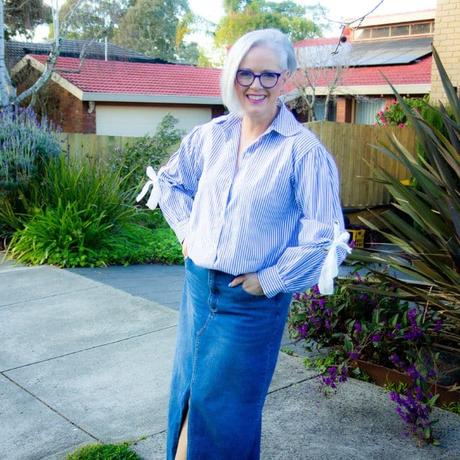
When I saw this blue and white striped shirt in a store (on my recent trip to Thailand), I knew it was for me. If it didn't have the bows at the elbows I wouldn't have bought it, but this detail took it from boring to interesting for me, plus it's super comfortable to wear.
Style Tip: Don't be afraid to mix in some fun, statement pieces that bring you joy. Whether it's a colourful scarf or a bold piece of jewellery, these little touches can lift your mood and make your wardrobe feel more personal and intentional.
6. Sustainability as Self-Care: Mindful Shopping for Emotional Well-Being
Finally, building a therapeutic wardrobe is also about being mindful of how and where you shop. Fast fashion can leave us feeling overwhelmed with choices and disconnected from our clothes. By choosing to invest in fewer, high-quality pieces that align with your values, you create a wardrobe that feels more meaningful.
Sustainable fashion is not only better for the environment, but it can also enhance your sense of well-being. Knowing that the clothes you wear are made ethically can bring peace of mind and a deeper sense of connection to your wardrobe. Plus, high-quality pieces tend to last longer, which means they become trusted staples that you can turn to time and time again.
Style Tip: Consider creating a capsule wardrobe of timeless, sustainable pieces that you can mix and match. This approach not only simplifies your wardrobe but also reduces decision fatigue, making your daily dressing routine a more relaxing and enjoyable experience.
7. The Emotional Power of Accessories
Don't forget the small but mighty role of accessories in a therapeutic wardrobe. A well-chosen scarf, a sentimental piece of jewellery, or a beloved pair of shoes can instantly change how you feel. Accessories are often the finishing touches that make an outfit feel complete, and they offer another layer of personal expression.
Incorporating accessories that have personal meaning-whether it's a necklace gifted by a loved one or a bracelet picked up on a special trip-adds an emotional layer to your wardrobe that enhances its therapeutic power.
Alternatively, it could just be the accessories that make you feel that your outfit is finished, without them having any sentimental attachment at all. The choice is yours! For me, when I have an accessory that works in harmony with my outfit it doesn't have to hold meaning, it just has to be aesthetically pleasing to me.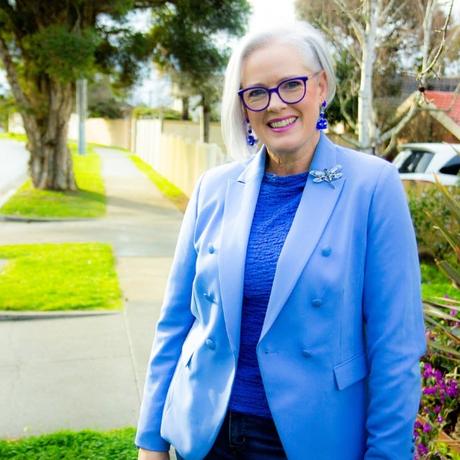
These earrings are ones I made and I love this colour (it's a favourite colour) and I love their boldness and they make me feel just a little more glamorous, even when I'm wearing jeans.
Style Tip: Keep a few "go-to" accessories that hold personal significance. These items can serve as emotional anchors, grounding you and bringing comfort or confidence when you wear them
Fashion, when approached as an act of self-care, becomes more than just getting dressed-it's a way to nurture your mind, body, and spirit. By building a wardrobe that prioritises comfort, empowerment, joy, and sustainability, you can create a daily dressing ritual that supports your emotional well-being.
Recommended Reading
Your Ultimate Guide to Creating Wardrobe Capsules
How to Combine Clothes and Accessories Harmoniously and Interestingly
What are Mental and Emotional Comfort with Regards to Personal Style?
How to Choose Colours to Wear to Suit Your Mood



